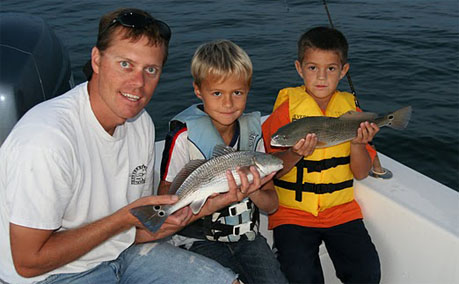Fishing the Southern Outer Banks
The waters of North Carolina's Crystal Coast present one of the most diverse maritime ecosystems around. Experienced fishermen flock to the area year after year thanks to its impressive variety of marine life. And it's a great spot for beginners to learn why so many of us are passionate about our sport.
See our Fishing Calendar below to learn more about the best fishing times throughout the year. And be sure to ask Captains Bo and Chuck where you can find the big ones!
Noah's Ark Fishing Charters
If you're interested in booking a private charter or trips and outings for your family, check out Noah Lynk, an experienced captain and fishing guide operating out of Cape Pointe Marina. Year-round, we're here to help you with everything you need.
World Class Fishing Throughout the Year
SPRING FISHING
March Depending on the weather (early or late Spring), albacore and blue fish begin to arrive with the bait fish. The blue fish usually have good size by the end of this March. Along with "alberts" and blues, puppy drum start to get active, feeding along area beaches and around structures and oyster rocks where bait fish tend to congregate.
April With the start of April, Spring is in full swing and so is the fishing! Cobia is the name of the game in April as they start to move in from the South, mainly caught on the bottom. These fish can be caught top water also. These fish range anywhere from around 25 to 85 pounds and are a blast to catch! Along with cobia come more blue fish, red drum and scattered flounder as they move in from offshore.
May The month of May brings red hot cobia fishing (this is when most of the big cobia are caught). Big blues are caught while fishing for cobia. Spanish Mackeral and King Mackeral start to show up now and flounder are now in the rocks and offshore waters. Near shore, wrecks and rock piles are showing good bottom fish.
SUMMER FISHING
June, July and August Usually around the first two weeks in June is about the end of the cobia run. Now is the best action for Spanish and King Mackeral (live bait and trolling). Blues and flounder are near shore and reefs are producing good amberjacks and reef fish, B-lines, grouper, and black bass. This pretty much runs the same throughout the summer through August.
A very special treat for the light tackle angler is catching lady fish at night. These fish are known as poor man's tarpon, and for those of you who have ever seen tarpon run and dance, this is the next best thing. They put on quite a show running and dancing all over the water when they are caught. This is a fly fishing and light tackle dream fish! They are very active and fun to catch and are biting at night all summer long! If you haven't tried it, you need to check this out!
FALL FISHING
September As September comes in, the water starts to cool down and the fishing really starts to heat up. During this time of year, everything is biting: drum, spanish mackeral, king mackeral, big blues, and big flounder. Toward the end of September, the albacore start to show up, especially at/around Cape Lookout shoals.
October October brings in the grey trout (weak fish) to the area beaches, rock jetties and sounds (marshes, etc.). Speckled trout start to show near the end of October. Fall albacore season is in full swing with alberts taking over from Emerald Isle to Cape Lookout. This is some of the hottest light tackle fishing around!
November November is best known for speckled trout (3-7 lb range), as well as fall alberts. It doesn't get any better than this! Scattered red drum and flounder can also be found on the outside beaches.
WINTER FISHING
December The last month of the year brings good puppy drum and black drum fishing along outer island beaches and slews as well as some big speckled trout. Live shrimp can just about guarantee a good catch.
January January usually brings lots of bait to the Cape Lookout Shoals area and with it come stripers (rock fish) and red drum school along the Outer Banks. Speckled trout show up at the rock jetties and along the beaches. This fishing usually lasts into the first week of February. Most, if not all, winter fishing in the Cape Lookout area needs to have good weather. Temperatures in the 50's - 60's with light wind works best.
February Usually this month is reserved for boat repairs and getting ready for the Spring and Summer and attending boat and fishing shows.

